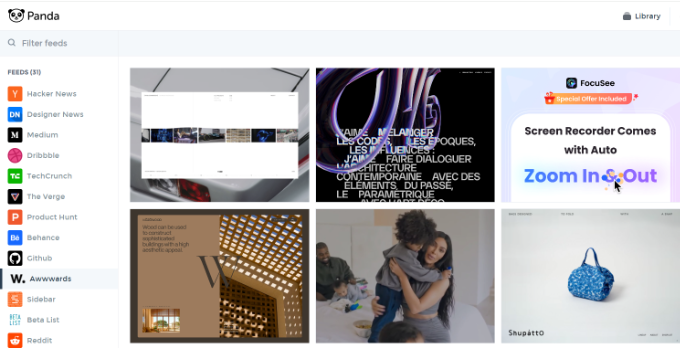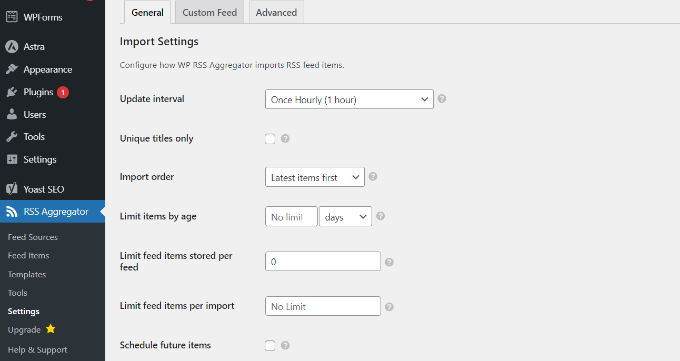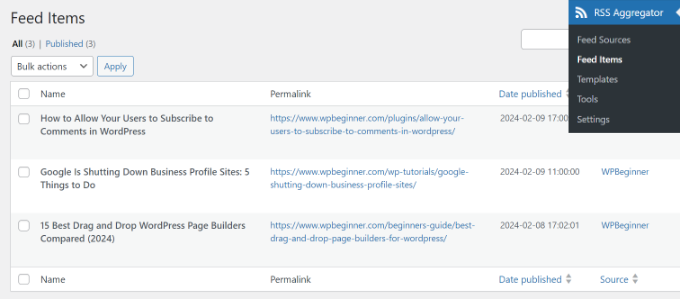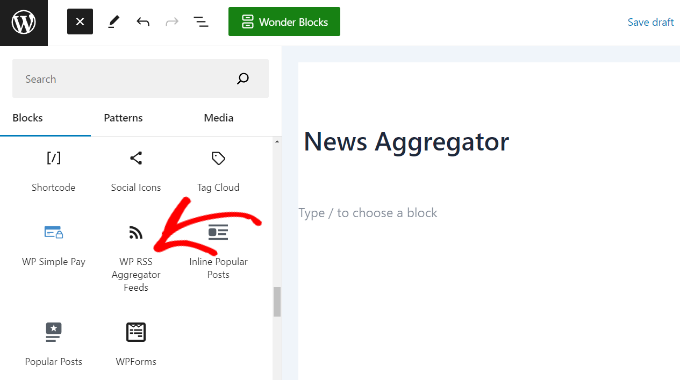Do you want to read the latest news and updates from your favorite blogs all in one place?
If so, then news aggregator websites are the best option for you. These websites automatically show your favorite websites’ latest content on one page. This way, you can quickly get all your news and blog updates without missing anything.
In this article, we will share our pick of the best news aggregator websites. We will also show you how to build a news aggregator website of your own using WordPress.
What Are News Aggregator Websites?
News aggregator websites allow users to view news and updates from various sources at one convenient location. They fetch the data, organize them in tags/categories, and display it in the right order for easier consumption.
You can also think of them as a compilation of news and updates presented according to the user’s preference.
Using news aggregators, you don’t need to visit different websites for their latest content. Instead, you can find all the content in one place.
There are different types of content aggregators on the internet. Some are like Google News, which simply gathers articles from popular online newspapers and displays them in related categories.
On the other hand, there are others like Feedly, which offer a more personalized experience. They allow you to create your own feed with your selected publishers.
Most of the news aggregators don’t publish their own content. They fetch articles from other websites using their RSS feeds, which is why they are called feed readers as well.
With that said, let’s take a look at the best news aggregator websites.
1. Feedly

Feedly is one of the most popular news aggregator websites on the internet. It allows you to create a news stream of your own with the latest content from your favorite publishers.
Using this platform, you can subscribe to content about a wide variety of topics. You can use their content suggestion engine to discover new websites by topics. Feedly offers an AI-powered solution to help researchers and analysts gather actionable insights.
You can also manually add your favorite news websites or blogs. For example, you can subscribe to WPBeginner for WordPress-related articles.
Feedly is available in both free and paid versions. The free plan lets you subscribe to 100 sources and create up to 3 personal feeds. You can use Feedly in the browser or download it as a mobile app or browser extension.
Besides that, Feedly also offers a Market Intelligence tool that gathers a full view of your competition and industry trends in an organized manner.
Why You Should Use Feedly: The news aggregator is best for researchers and analysts who are looking for content for their research. Feedly uses AI to gather news by topics and it also lets you subscribe to specific sites to get news on particular topics.
2. Google News

Google News is a powerful news aggregator powered by Google’s sophisticated search technologies, AI, and user’s own search history. By default, it shows you top news stories based on your geographical location.
It offers the latest news and updates for local, regional, international, business, technology, entertainment, sports, science, and health news.
You can save topics, sources, and searches to customize your feed.
Google News is a free news aggregator that you can use on the web, on your Android, and iOS devices.
If you are looking for a non-Google alternative, then Bing News and Yahoo News offer similar functionality.
Why You Should Use Google News: It is perfect for anyone looking to discover current events, the latest news from around the world, and content from different publishers.
3. AllTop

AllTop aggregates news and blog articles from the world’s most popular websites like TechCrunch, Mashable, BBC, CNN, and more. It curates and displays content in real time.
There are separate categories for politics, tech news, sports, entertainment, lifestyle, business, etc. Upon clicking on those categories, you can find the most popular stories, as well as top stories from the top sources in the related topic.
Besides the most recent news, it has a viral category where it showcases the latest viral content and trends.
Why You Should Use AllTop: If you want to view the latest news and content from the most popular websites in the world, then we highly recommend AllTop. It displays news and blog posts in a single place, so you don’t have to switch between multiple tabs or visit each site manually.
4. PressReader

PressReader (formerly known as News360) is one of the most popular news aggregator apps on the internet. It lets you find world news as well as stories about your interests. It is an excellent alternative to Google News and Feedly.
As you sign up for PressReader, you can choose the topics you are interested in, and then it will show you the latest content on those topics. This gives you a healthy news stream out of the box, which you can further customize by adding or removing topics and sources.
PressReader lets you get the most important news from over 7,000 trusted publications on the internet. You can also read PressReader in your browser or on iOS and Android devices.
Why You Should Use PressReader: PressReader offers features similar to those of Google News and Feedly. So, if anyone is looking for an alternative to these two news aggregators, then PressReader is the best solution.
5. Panda

Panda aggregates content that is useful to web designers, developers, and tech entrepreneurs. It differs from other news aggregators, as it gathers content from Dribble, Behance, TechCrunch, Wired, and other similar websites.
As a niche news aggregator, Panda displays the news in a more engaging layout, allowing you to discover the most interesting content. Plus, you can switch to different layouts.
Besides that, it lets you create multiple feeds from different sources. For example, you can set up a feed for marketing, development, news, photography, and other topics.
Why You Should Use Panda: Unlike other news aggregators, Panda displays content in a more engaging way. You can create feeds for multiple sources and sort them by topics.
6. Techmeme

Techmeme is a tech news aggregator website. It covers top stories about technology from various reliable sources like TechCrunch, Wired, the New York Times, and more.
The homepage features top trending news in the tech sphere, sponsor posts, jobs, and upcoming tech events. Users can also switch to the River view for updates as they come or the Leaderboard view, which shows content by topic.
Techmeme is a good starting point for anyone looking for an easier way to stay up to date with the latest tech news.
Why You Should Use Techmeme: This news aggregator is great for anyone looking for news and content about technology. Techmeme gathers blog posts and the latest news from popular tech websites.
7. Flipboard

Flipboard is an excellent blog aggregator site that allows you to create your own content feed based on your interests. It includes a wide range of topics, including business news, tech news, travel, politics news, beauty, and more.
You can also use Flipboard as a local news aggregator because it has feeds for almost all the cities in the world.
Flipboard has a stunning magazine-style layout that comes with interactive options to like, comment, and share content across your social media profiles.
Flipboard is available via browser or mobile apps for Android or iOS devices.
Why You Should Use Flipboard: While testing several news aggregators, one thing that stood out in Flipboard was its custom news feeds. While it offers content from topics, you can create your own feed based on your interests.
8. Pocket

Pocket is another news aggregator app where you can explore the most popular content across the internet. It also lets you create your own reading space by saving your favorite content.
Pocket features different types of content, including articles, videos, and stories from a wide range of publications. It has various content categories like must-reads, trending, tech, finance, health, and more for easy browsing.
It allows you to save content to read later while on the go, and it is available as browser extensions as well as mobile apps.
Why You Should Use Pocket: Using Pocket, you can quickly save and organize content from the internet. It helps in creating a personal library of content.
9. Inoreader

Inoreader is a powerful Feedly alternative and excellent feed-reader software. Available on the web, iOS, and Android devices, Innoreader allows you to easily add your favorite websites or find new blogs to subscribe to.
It offers tons of options to curate, rearrange, and display content in different layouts and color schemes.
If you are already using a news reader, then you can easily import your subscriptions. As your reading list grows, you’ll also be able to manage subscriptions in bundles and topics.
Aside from following news from websites and creators, you can also set up monitoring feeds to track brands, companies, trends, and more. There is also an option for social listening, where you can see what brands are posting on Facebook, Reddit, Mastodon, and Telegram.
Why You Should Use Inoreader: If you are looking for a Feedly alternative, then Inoreader is a great solution. It lets you create your own news feeds, monitor news from different brands, and keep track of the latest trends.
Honourable Mentions
Well, that was our list of news aggregators to follow! But there are many more news aggregators. Here are some honorable mentions you may want to check out.
How to Build a News Aggregator Website with WordPress
News aggregator websites are immensely useful, and there are so many niches that are completely untapped. By creating a news aggregator website catering to those niches, you can easily make money online by selling subscriptions, sponsorships, and advertisements.
The best part is that you’ll curate the content instead of creating your original content. You could offer highly useful information to your users from the top sources.
Let’s take a step-by-step look at how to easily create your own news aggregator website.
Step 1: Setting up Your News Aggregator Website
You can make a news aggregator website using other website builders or writing your own custom code. Both options are quite difficult for a beginner-level user with no programming skills.
The easiest way to do this is by using WordPress.
There are two types of websites: WordPress.com and WordPress.org. You’ll need WordPress.org because it gives you full freedom and flexibility out of the box.
To learn more, see our guide on the difference between WordPress.com vs. WordPress.org.
To start with WordPress.org, you’ll need a web hosting account and a domain name.
Normally, a domain name costs $14.99 per year, and a WordPress hosting plan costs $7.99 per month. And since all websites need SSL, you can add an additional $69.99 per year to that total. This is quite a lot of money.
Luckily, Bluehost has agreed to offer our users a discount on hosting with a free domain name + free SSL certificate. Basically, you’ll be able to get started for just $2.75 per month.
Simply visit the Bluehost website to complete the purchase, and then head over to our guide on how to create a WordPress website for step-by-step setup instructions.
Step 2: Install and Activate WP RSS Aggregator Plugin
After you have set up your WordPress website, the next step is to install and activate the WP RSS Aggregator plugin. For more details, see our step-by-step guide on how to install a plugin in WordPress.
WP RSS Aggregator is the best WordPress plugin to turn a WordPress website into a content aggregator. It allows you to import, merge, and display RSS feeds on your WordPress website without any coding.
Upon activation, visit RSS Aggregator » Settings from your dashboard to configure the plugin settings.

The default settings will work for most websites. However, you may still need to review and change them.
For instance, there are options to change the update interval, limit items by day, change import order, and more.
Step 3. Add Feed Sources to Import Feed Items
Now, your website is ready to start displaying news feeds. You just need to add the sources that you want to display on your website.
WP RSS Aggregator can fetch and display content from any website with an RSS feed. Most news and blog websites have an RSS feed.
First, go to the RSS Aggregator » Feed Sources page from your dashboard, and then click on the ‘Add New’ button.

After that, you can add your feed source.
Enter the name of the feed source website, such as WPBeginner.

Next, you need to enter the feed source URL. In most cases, you can simply enter the website URL.
You can also click on the ‘Validate feed’ link below the URL field to test the RSS feed validity.

If the link is valid, then you can publish your feed source.
Once done, the plugin will immediately start to import feed items (depending on the feed processing interval).
You can see the imported feed items by going to RSS Aggregator » Feed Items.

After that, repeat the process to add more feed sources to your website.
Step 4: Publish Your Content Aggregator Live
Now that you have feed items imported, you can publish your aggregated articles live on your website.
First, you’ll need to create a new page or post to publish your content feed. Next, you will need to click the ‘+’ button to add a new block and choose the WP RSS Aggregator block under the Widgets section.

Once done, the plugin will automatically load your WordPress feed.
Now you can publish your page and view your content feed live. Here is how it looked on your demo website.

We hope this article helped you learn about the best news aggregator websites and how to build your own in WordPress. You may also want to see our guide on optimizing your RSS feed and how to do content syndication in WordPress.
If you liked this article, then please subscribe to our YouTube Channel for WordPress video tutorials. You can also find us on Twitter and Facebook.
Leave A Comment
You must be logged in to post a comment.